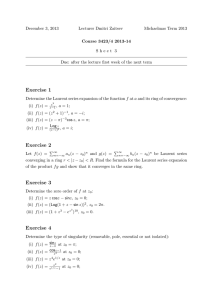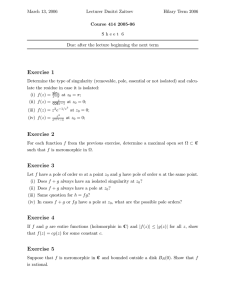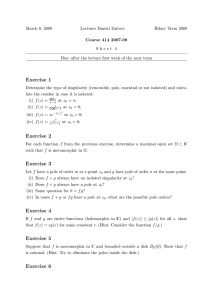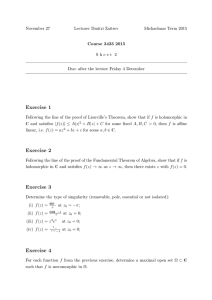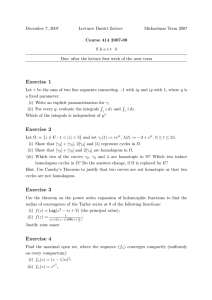April 24, 2008 Lecturer Dmitri Zaitsev Hilary Term 2008 Course 414 2007-08
advertisement
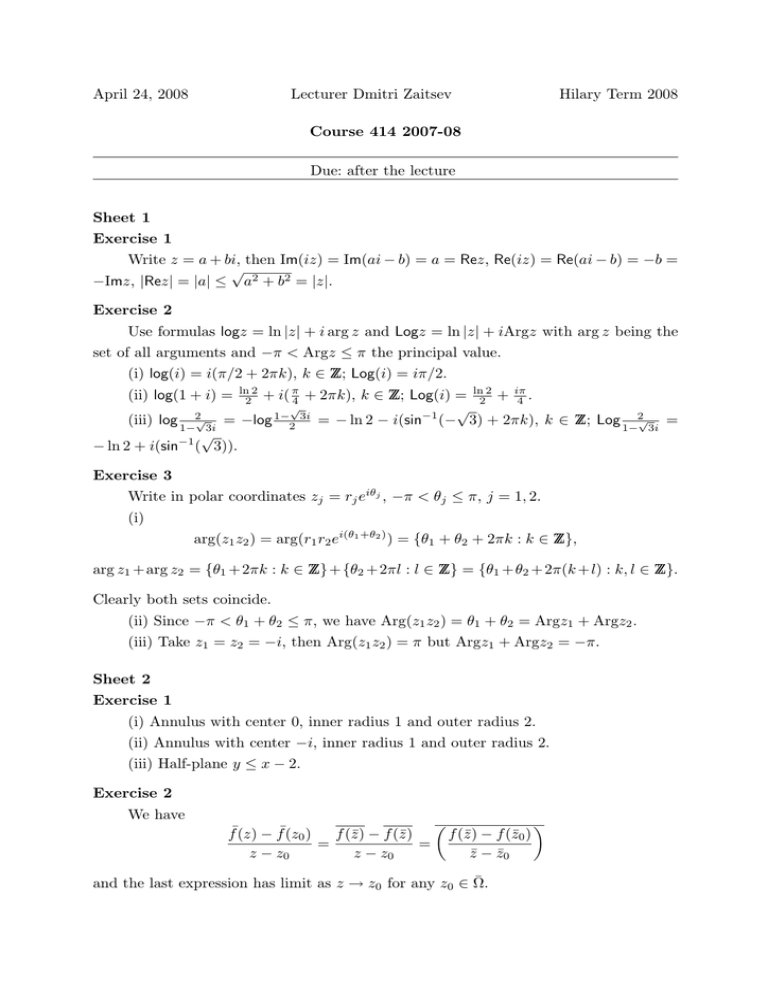
April 24, 2008
Lecturer Dmitri Zaitsev
Hilary Term 2008
Course 414 2007-08
Due: after the lecture
Sheet 1
Exercise 1
Write z = a + bi, then Im(iz) = Im(ai − b) = a = Rez, Re(iz) = Re(ai − b) = −b =
√
−Imz, |Rez| = |a| ≤ a2 + b2 = |z|.
Exercise 2
Use formulas logz = ln |z| + i arg z and Logz = ln |z| + iArgz with arg z being the
set of all arguments and −π < Argz ≤ π the principal value.
(i) log(i) = i(π/2 + 2πk), k ∈ ZZ; Log(i) = iπ/2.
(ii) log(1 + i) = ln22 + i( π4 + 2πk), k ∈ ZZ; Log(i) = ln22 + iπ
4 .
√
√
(iii) log 1−2√3i = −log 1−2 3i = − ln 2 − i(sin−1 (− 3) + 2πk), k ∈ ZZ; Log 1−2√3i =
√
− ln 2 + i(sin−1 ( 3)).
Exercise 3
Write in polar coordinates zj = rj eiθj , −π < θj ≤ π, j = 1, 2.
(i)
arg(z1 z2 ) = arg(r1 r2 ei(θ1 +θ2 ) ) = {θ1 + θ2 + 2πk : k ∈ ZZ},
arg z1 +arg z2 = {θ1 +2πk : k ∈ ZZ}+{θ2 +2πl : l ∈ ZZ} = {θ1 +θ2 +2π(k +l) : k, l ∈ ZZ}.
Clearly both sets coincide.
(ii) Since −π < θ1 + θ2 ≤ π, we have Arg(z1 z2 ) = θ1 + θ2 = Argz1 + Argz2 .
(iii) Take z1 = z2 = −i, then Arg(z1 z2 ) = π but Argz1 + Argz2 = −π.
Sheet 2
Exercise 1
(i) Annulus with center 0, inner radius 1 and outer radius 2.
(ii) Annulus with center −i, inner radius 1 and outer radius 2.
(iii) Half-plane y ≤ x − 2.
Exercise 2
We have
f¯(z) − f¯(z0 )
f (z̄) − f (z̄)
f (z̄) − f (z̄0 )
=
=
z − z0
z − z0
z̄ − z̄0
and the last expression has limit as z → z0 for any z0 ∈ Ω̄.
Exercise 3
(i) Writing f = u + iv with u, v real, we have u = const, hence ux = uy = 0. By
the Cauchy-Riemann equations, vx = −uy = 0, vy = ux = 0, hence also v = const as
desired.
(ii) Dividing by a and taking real part, we have
b
b
u + Re
v = Re
1 − iRe
f = const.
a
a
1 − iRe ab f = const and hence f = const.
Then by part (i),
Exercise 4
p
(i) Ω = C \ IR≥0 with a branch given by f (z) = |z|eiArgz/3 . Any other branch is
τ f (z), where τ is any 3rd root of unity. Since the limits of τ f (z) for every τ from above
and below do not coincide at every z ∈ IR>0 , τ f cannot be continuously extended to
e with a branch fe, that branch would
any such point. If there were a larger open set Ω
e cannot contain any point from
be a holomorphic extension of some branch τ f . Hence Ω
IR>0 and since it is open, it also cannot contain 0. Thus Ω is maximal.
(ii) Ω = C \ IR≥−1 with the branches given by fk (z) = ln |z| + iArg(z + 1) + 2iπk,
k ∈ ZZ. Maximality of Ω is shown by the same argument as in (i).
z
(iii) Ω = C with the branches ±e 2 .
Exercise 5
e [0, 1] × [a, b] → Ω by
Define Φ:
3(λ−a)
2a+b
Φ( b−a t, a), a ≤ λ ≤ 3 ,
e λ) := Φ(t, 3λ − a − b), 2a+b ≤ λ ≤
Φ(t,
3
3(b−λ)
Φ( b−a t, a), a+2b
≤ λ ≤ b,
3
e the homotopy with fixed endpoints. Moreover,
then Φ
R
e λ). The conclusion follows from Cauchy’s theorem.
Φ(t,
γt
a+2b
3 ,
R
f dz with γ
et (λ) :=
f dz = e
γt
Sheet 3
Exercise 1
(i)
γ(t) =
t + iy(1 + t),
t + iy(1 − t),
−1 ≤ t ≤ 0
0≤t≤1
(ii)
Z
γ
z dz =
Z
0
−1
(t + iy(1 + t))(1 + iy)dt +
Z
0
−1
(t + iy(1 − t))(1 − iy)dt = . . .
Z
z̄ dz =
γ
Z
0
−1
(t − iy(1 + t))(1 + iy)dt +
Z
0
−1
(t − iy(1 − t))(1 − iy)dt = . . .
Exercise 2 (i) For every arc γ: [0, 2π] → C with γ(0) = γ(2π), ∂[γ] = 0, hence [γ] is a
cycle and sums of cycles are cycles.
(ii) [γ4 ] − [γr ] bounds an annulus inside Ω that can be triangulated into a sum of
2-chains. Hence [γ4 ] − [γr ] is the boundary of a 2-chain and hence is null-homologous
for each r. Then also the sum
([γ4 ] − [γ2 ]) + ([γ4 ] − [γ3 ]) = 2[γ4 ] − ([γ2 ] + [γ3 ])
is null-homologous and the needed conclusion follows.
(iii) γ2 and γ3 are homotopic to each other but are not homotopic to λ in Ω.
The cycles [γ2 ] and [γ3 ] are homologous but not homologous to [λ] in Ω. A homotopy
between γ2 and γ3 is given by Φ(s, t) = (2 + s)eit , 0 ≤ s ≤ 1. The cycle [γ2 ] − [γ3 ]
bounds an annulus in Ω that can be triangulated into a sum of 2-chains, hence it is
null-homologous. The integral of f (z) = z1 over λ is 0 by the Cauchy’s theorem. On the
other hand, the integral of f (z) over γr is 2iπ. This proves the claims.
If Ω is replaced by C, all arcs become homotopic and all cycles homologous.
Exercise 3
(i) The equation z 2 − iz + 2 = 0 has solutions z = −i and z = 2i. Hence the
maximal disk cetered at 0, where the function is holomorphic, has radius 1 and therefore
the radius of convergence is 1.
(ii) The radius is again 1 with the same argument.
Exercise 4
(i) Convergence is uniform on every compactum in C, hence the maximal open set
is C.
(ii) Convergence is uniform on every compactum in the unit disk ∆. The sequence
is divergent at every z with |z| > 1. Thus the unit disk cannot be replaced by any larger
open set and is hence maximal.
(iii) The sequence is convergent for every z with Rez < 0 and divergent for every z
with Rez > 0. Hence the desired open set Ω is contained in Rez < 0. Direct calculation
shows that the sequence converges uniformly on every set Rez ≤ −ε for ε > 0, hence on
every compactum in Ω. The divergence for Rez > 0 shows that Ω is maximal.
Exercise 5
(i) If (fn ) and (gn ) converge uniformly to functions f and g on a compactum K,
then
sup |fn (z) − f (z)| → 0,
z∈K
sup |gn (z) − g(z)| → 0,
z∈K
as n → ∞, which implies
sup |(fn (z) + gn (z)) − (f (z) + g(z))| → 0,
z∈K
proving uniform convergence of fn + gn to f + g on K. The corresponding proof for
fn gn follows from the estimate
|fn (z)gn (z) − f (z)g(z)| = |fn (z)gn (z) − fn (z)g(z) + fn (z)g(z) − f (z)g(z)|
≤ |fn (z)||gn (z) − g(z)| + |g(z)||fn (z) − f (z)|,
the boundedness of g on K and uniform boundedness of fn on K.
(ii) The sequence fn /gn is not always convergent, e.g. take constant functions
fn = 1, gn = 1/n.
Exercise 6
(i) The function is holomorphic away from its poles z = ±i. Hence it is holomorphic
in two maximal rings centered at i:
R1 := {0 < |z − i| < 2},
R2 := {2 < |z − i|}
Expand into powers of (z − i):
f (z) =
1
1
1
=
(z + i)(z − i)
z − i 2i + (z − i)
In R1 we have the Larent series
k X
∞
∞ z−i
(−1)k (z − i)k−1
1 1 X
1
1
=
−
=
,
f (z) =
z − i 2i(1 + (z − i)/2i)
2i z − i
2i
(2i)k+1
k=0
k=0
whose ring of convergence is R1 .
In R2 we have the Larent series
k X
∞
∞ X
(−2i)k
−2i
1
1
1
=
f (z) =
=
(z − i)2 (1 + 2i/(z − i))
(z − i)2
z−i
(z − i)k+2
k=0
k=0
whose ring of convergence is R2 .
(ii) The function is holomorphic in the ring R := {0 < |z − 1| < 1} centered at 1,
which is maximal with this property. Hence there is one Laurent series expansion with
ring of convergence R. To find it, expand into powers of (z − 1):
∞
∞
X
X
1
(−(z − 1))k
(−(z − 1))k−2
1
Log(1
+
(z
−
1))
=
=
.
f (z) =
(z − 1)2
(z − 1)2
k
k
k=0
k=0
(iii) The function is holomorphic away from its poles z = 0 and z = 2, hence it is
holomorphic in two maximal rings centered at 2:
R1 := {0 < |z − 2| < 2},
R2 := {2 < |z − 2|}.
The corresponding Laurent series with rings of convergence R1 and R2 are respectively
∞
X (−π(z − 2))k
cos(π(z − 2))
1
1
=
(z − 2)3 (2 + (z − 2))
(z − 2)3 2(1 + (z − 2)/2)
k!
k=0
1
1
=
3
(z − 2) 2
s
∞ X
z−2
−
2
s=0
=
∞
X
l=−3
and
!
∞
X
(−π(z − 2))k
k!
k=0
X
!
k
=
X (−π)k (−1)s
(z − 2)s+k−3
2s+1 k!
s,k≥0
s
(−π) (−1)
(z − 2)l
2s+1 k!
s,k≥0,s+k−3=l
∞
X (−π(z − 2))k
cos(π(z − 2))
1
1
=
(z − 2)3 (2 + (z − 2))
(z − 2)4 1 + 2/(z − 2)
k!
k=0
1
=
(z − 2)4
s
∞ X
2
−
z−2
s=0
=
∞
X
l=−∞
!
∞
X
(−π(z − 2))k
k!
k=0
X
!
k
s,k≥0,k−s−4=l
=
X (−π)k (−2)s
(z − 2)k−s−4
k!
s,k≥0
s
(−π) (−2)
(z − 2)l .
k!
Exercise 7
The formula for the Laurent series expansion of the product f g is obtained by
taking the product of both Laurent series:
f (z)g(z) =
X
k,n
ak bn (z − z0 )k+n =
X
l
X
k,n,k+n=l
ak bn (z − z0 )l =
X
l
cl (z − z0 )l .
To prove convergence, remark that the Laurent series converge absolutely in their
rings of convergence, hence we have
X
n
X
|an ||z − z0 |n < ∞,
k
|bk ||z − z0 |k < ∞
and then
X
k,n
|ak bn ||z − z0 |k+n =
In particular, each coefficient cl =
X
l
P
k,n,k+n=l
k,n,k+n=l
convergent series), and the Laurent series
Exercise 8
X
P
|ak bn | |z − z0 |l < ∞.
ak bn is well-defined (given by absolutely
l cl (z
− z0 )l is convergent in the given ring.
Use the Taylor series expansion in powers of (z − z0 ):
(i) Write
2
3
ezcosz−z = ez(1−z /2+...)−z = ez /2+...
= 1 + (z 3 /2 + . . .) + (z 3 /2 + . . .)2 /2 + . . . = 1 + z 3 /2 + . . . ,
then the multiplicity at 0 is the vanishing order of f − f (0), which is 3.
(ii) Write
(Log(cosz))2 = (Log(cos(z − 2π)))2 = (Log(1 − (z − 2π)2 /2 + . . .))2
= (1 − ((z − 2π)2 /2 + . . .) + . . .)2 = 1 − (z − 2π)2 + . . . ,
then the multiplicity at 2π is the vanishing order of f − f (2π), which is 2.
(iii) Write
2
(1 + z 2 − ez )4 = (1 + z 2 − (1 + z 2 + z 4 /2 + . . .))4 = (−z 4 /2 + . . .)4 = z 16 /24 + . . . ,
hence the multiplicty is 16.
Sheet 4
Exercise 1
(i) The function is ratio of two holomorphic functions, hence it is meromorphic
and therefore the singularity is either removable or pole. Expanding in the powers of
(z − z0 ), we obtain
sinz
−sin(z − π)
−(z − π) + . . .
=
=
= −1 + . . . ,
z−π
z−π
z−π
which is a Laurent series with trivial principal part, hence the singularity is removable.
The residue is zero.
(ii) The function is again meromorphic and we have
z
z
−1
−2
=
=
=
(1 + . . .),
2
cosz − 1
(1 − z /2 + . . .) − 1
z/2 + . . .
z
hence we have a pole at 0 and the Laurent coefficient of 1/z is −2. Thus the residue is
−2.
(iii) Expand as before:
ze
−1/z 3
k
∞ X
−1
1
=z
,
3
z
k!
k=0
which is a Laurent series with infinite principal part. Hence the singularity is essential
and the residue is the coefficient of 1/z, which is 0.
(iv) The function has poles when e1/z = 1, i.e. at the points z =
Hence 0 is not an isolated singularity.
1
2iπk ,
k ∈ ZZ.
Exercise 2
Ω = C for (i) and (ii) and Ω = C \ {0} for (iii) and (iv).
Exercise 3
(i) f + g is always defined and holomorphic in a punctured disk centered at z0 ,
hence has an isolated singularity there.
(ii) f + g may not have a pole, e.g. f (z) = 1/z, g(z) = −1/z.
(iii) f g always has isolated singularity and a pole, which follows from the factorization lemma into a power of (z − z0 ) and a nonvanishing holomorphic function.
(iv) the pole order of f g is the sum of pole orders of f and g as follows from the
factorization. The pole order of f + g is best understood by looking at the Laurent series
expansions. If the pole orders of f and g are different, the term with the lowest power of
(z − z0 ) is present in the expansion of f + g, hence in this case the pole order of f + g is
the maximum of the pole orders of f and g. On the other hand, if both orders are equal,
there may be some cancellation of terms when adding two Laurent series expansions.
In that case the pole order of f + g can be any number between 1 and the maximum of
the pole orders of f and g.
Exercise 4
If g = 0, then f = 0 and the needed conclusion is trivial. Otherwise f /g is meromorphic, in particular all its singularities are isolated. Since |f /g| ≤ 1 away from the
singularities, the Riemann extension theorem implies that all singularities are removable. Hence h = f /g extends to an entire function, which is bounded by 1 aways from
singularities and hence everywhere by continuity. Now Liouville’s theorem implies that
h is constant, hence the conclusion.
Exercise 5
Since f is bounded outside the disk, its poles can only be inside, hence there
are finitely many of them (the set of poles has no limit points in the set where f is
meromorphic).
We prove the claim by induction on the number of poles. If there are no poles, f is
holomorphic and bounded both inside and outside the disk. Hence Liouville’s theorem
applies and f must be constant, hence rational.
Now suppose the claim holds whenever the number of poles is < k and consider f
with k poles. Let z0 be one of them. Expand f in Laurent series near z0 :
f (z) =
X
k<0
ck (z − z0 )k +
X
k≥0
ck (z − z0 )k = P (z) + R(z),
where the principal part P (z) is a finite sum, hence rational and bounded outside the
given disk BR (0). Moreover, the only pole of P is at z0 . Therefore, R(z) := f (z) − P (z)
is also meromorphic on C, bounded outside the disk BR (0) and has less poles than f (z).
By the induction assumption, R(z) is rational. Since P (z) is rational, f (z) = P (z)+R(z)
is rational as desired.
Exercise 6
(i) Set F (z) = 5z 4 , f (z) = z 6 + z 3 − 2z, then |f (z)| < |F (z)| on the unit circle,
hence by Rouché’s theorem, the number of zeroes inside the circle for F + f is the same
as for F , which is 4.
(ii) Similarly setting F (z) = 7 and f (z) = 2z 4 − 2z 3 + z 2 − z, we see that the
number of zeroes of F + f inside the unit circle is 0.
Exercise 7
z−1 1
z 2;
z−1
= z−a
a
(i) ϕ(z) =
(ii) ϕ(z)
a = ∞);
for any a ∈
/ {0, 1} or ϕ(z) = 1 − z (which is corresponds to
(iii) Substituting ϕ(0) = ∞ into ϕ(z) =
az+b
cz+d
gives d = 0, thus ϕ(z) =
az+b
z
(dividing by c and renaming a and b) for any a 6= 0 and any b.
Exercise 8
If z0 ∈ Ω is a limit point of f −1 (∞), then f (z0 ) = ∞ and hence g := 1/f is
holomorphic in a neighborhood of z0 , with z0 being a limit point for the set of zeroes
of g. Then, by the identity principle, g ≡ 0 and hence f ≡ ∞ in a neighborhood of z0 .
Assume that the set S ⊂ Ω consisting of all limit points of f −1 (∞) is nonempty. It
is clearly a closed set in Ω. Furthermore, the above remark implies that S is also open
in Ω. Since Ω is connected, it follows that S = Ω and therefore f ≡ ∞.
Exercise 9
The function ez maps the strip 0 < Imz < 2π biholomorphically onto the upper
half-plane, hence f (z) := eπ(z+i) maps |Imz| < 1 biholomorphically onto the upper
Logw
half-plane with the inverse f −1 (w) = π − i. Any biholomorphic automorphism of
the upper half-plane is a Möbius transformation ϕ(z) = az+b
cz+d with a, b, c, d ∈ IR and
a b
> 0. Hence any biholomorphic automorphism of |Imz| < 1 is of the form
det
c d
ϕ
e = f −1 ◦ ϕ ◦ f with f and ϕ as above.
Exercise 10
Any 3 disjoint points of C either belong to one uniquely determined line or a circle
(use elementary geometry). If any of these points is ∞, a suitable Möbius transformation
ϕ maps them all into C, where they determine an unique generalized circle C, then
ϕ−1 (C) is the uniquely determined generalized circle through the given points.
Now suppose we are given two generalized circles C1 and C2 . Take any 3 disjoint
points on each of them. Then there exists a Möbius transformation ψ sending the first
triplet of points into the second. It always sends generalized circles into generalized
circles. Furthermore, the uniqueness of such circles through a triplet of points implies
that ψ(C1 ) = C2 .



